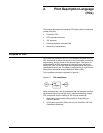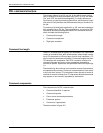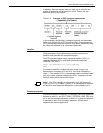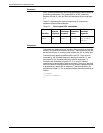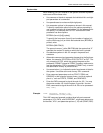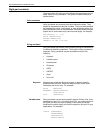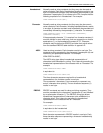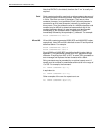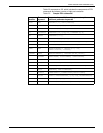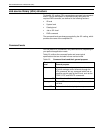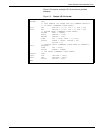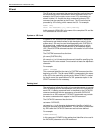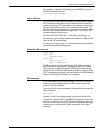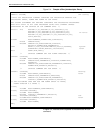
PRINT DESCRIPTION LANGUAGE (PDL)
XEROX DOCUPRINT 180 LPS PDL REFERENCE 2-7
Hexadecimal Normally used as string constants, but they may also be used as
value constants. Each pair of hexadecimal characters results in one
byte. A hexadecimal constant must immediately be preceded by the
characters X apostrophe (X) to indicate to the PDL compiler that the
following expression is in hexadecimal. For example:
IDEN PREFIX=X’C1C2C3C4’;
Character Normally used as string constants, but they may also be numeric
value constants. Each character, including embedded blanks, results
in one byte. A character constant must immediately be preceded and
immediately followed by the apostrophe (’) character. For example:
IDEN PREFIX=’THIS IS A CHARACTER CONSTANT’;
CONSTANT=’ABCDE’;
If the apostrophe character ’(’)’ is required in a character constant, it
must be defined in some other way, such as consecutive or double
apostrophes ("), or the hexadecimal constant X’7D’. Character
constants may be defined as EBCDIC and take their actual values
from the standard EBCDIC table definition in appendix D.
ASCII Used as string constants. Each character results in one byte. The
constants must be preceded by the characters A apostrophe (A) and
followed by an apostrophe character. For example:
IDEN PREFIX=A'ABC';
The ASCII string type allows hexadecimal representation of
characters to be embedded in a string. This is done by preceding the
hexadecimal representation of the character with an ! character. For
example:
IDEN PREFIX=A’ABC!44EF’
is equivalent to
IDEN PREFIX=X’414243444546’
The three-character sequence required for a hexadecimal
representation of a character results in one byte.
Two successive ! characters (!!) are necessary to represent one
actual ! character when printing. The two-character sequence (!!)
results in one byte.
EBCDIC EBCDIC constants are used for value and string constants. They
must be preceded by the characters E apostrophe (E) and followed
by an apostrophe character (’). The EBCDIC string type allows
hexadecimal representation of characters to be embedded in a
character string. This is done by preceding the hexadecimal
representation of the character with an ! character.
For example:
IDEN PREFIX=E’ABC!C4EFG’
is equivalent to the hexadecimal
IDEN PREFIX=X’C1C2C3C4C5C6C7’
Each character represented in EBCDIC results in one byte. Each
three-character sequence representing a character hexadecimally
results in one byte.





